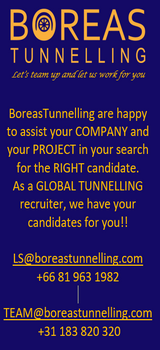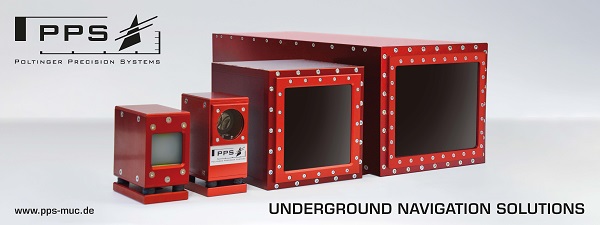Conventional Tunnelling versus Mechanized Tunnelling
Why choose Mechanized Tunnelling over Mechanized Tunnelling? Or vice versa? When to use Tunnel Boring Machine tunnelling method? When to use Drill and Blast tunnelling method?
First let's go over some definitions.
Conventional Tunnelling
Refers to creation of underground spaces mainly by means of manual-intensive processes and basic, general purpose tools.
Although involves relatively high rate of manual work, Conventional Tunnelling also employs explosives and mechanical tools. But they are mostly limited to basic tools like drills, excavators etc.
The most common example of Conventional Tunnelling is the 'Drill and Blast' method which uses explosives placed in drilled holes on the wall for excavation.
Mechanized Tunnelling
Refers to creation of underground spaces mainly by means of special purpose tunnelling machines which are in principle more automated and complex than the mechanized tools used in Conventional Tunnelling.
Mechanized Tunnelling is, if not fully, often fairly automated process and it is much less labour intensive than the Conventional Tunnelling.
The best example of Mechanised Tunnelling is the use of Tunnel Boring Machines for excavation and support creation. Mechanised Tunnelling is not limited to TBM usage though. There are other special purpose machines which are used for mechanized tunnelling, like shaft builders (vertical boring) or boom-type roadheaders.
Although TBM usage is currently the most common form of mechanized tunnelling, expect the rise of other new types of machinery as the use of underground space other than tunnelling increases in time.
Conventional Tunnelling versus Mechanized Tunnelling
Start-up Costs, Timing and the Length of the Tunnel
Conventional Tunnelling's startup costs are often lower. It also requires a shorter time to start the construction. In contrast, Mechanized Tunnelling requires a higher in-front investment for the machinery. Both in cost and the time. The price of a Tunnel Boring Machine starts from multi million US Dollars (How much does a Tunnel Boring Machine cost?). It also takes a lot of time to spec a Tunnel Boring Machine, to order and to get it manufactured (TBD: see How long does it take a Tunnel Boring Machine to be manufactured and delivered?).
And lastly, never underestimate the monetary and time costs of transporting and assembling a Tunnel Boring Machine to and at a tunnelling site. Assembly of a simple 6 meter in diameter TBM takes at least a month (if a manufacturer tells you 15 days, be prepared for additional days lost before the operation).
Conventional Tunnelling is, in general, still accepted as the effective method for tunnels shorter than 4 kilometers in length. Both in terms of the cost and the timing. Note that, there are cases where other factors may play more importantly than the monetary and time costs. For example, if you are doing underwater tunnelling (if for some reason, immerserd tunnelling method is not preferred), Mechanized Tunnelling can be the preferred method, even if it is for a few hundred meters of tunnelling.
Extreme Tunnelling
Generally, Mechanized Tunnelling, in the form of Tunnel Boring Machine tunnelling is considered more suitable in terms of safety, feasibility and cost for underwater tunnelling or tunnelling in ground with a lot of water and subsidence risk.
Safety
Mechanized Tunnelling, especially the one done by a Tunnel Boring Machine, is the undisputed winner here. The most important contribution of Tunnel Boring Machine is the standardization of the tunnelling process. Particularly the shield Tunnel Boring Machines provide better protection for the workers. Leaving this aside, nothing is more important for the health and safety of a tunnelling crew than a good measures of health and safety imposed by the tunnelling management and crew. No machine replaces it. An untrained Tunnel Boring Machine erector operator can easily hurt himself or an unchecked crew member can injure himself being on the rails when he should not be.
Flexibility
Conventional Tunnelling allows the switching of techniques while you are in the tunnel, It lets you change the horses while crossing the river, so to speak. It means, while excavating, if the soft ground unexpectedly turns to rocky ground, you can easily employ another technique more suitable for excavating the rock.
In the case of Mechanized Tunnelling, this switching of techniques in the midst of tunnelling can be more difficult, or less feasible. Undoubtedly mechanized tunnelling provides some techniques to deal with changing conditions, e.g. you can change the type of cutters mounted on the cutter head of a Tunnel Boring Machine to suit more to the conditions etc. But if a double shield Tunnel Boring Machine hits soft ground way into tunnelling, there is no feasible way of replacing it with a rock TBM or a single shield TBM. Overcoming such cases is very time and money consuming for Tunnel Boring Machine tunnelling. We can safely say that, switching techniques is also possible in Mechanized Tunnelling, but it is much more costly, compared to Conventional Tunnelling.
In view of the foregoing, it only emphasizes the importance of pre-tunnelling geological surveys before any actual tunnelling starts. A thorough pre-tunnelling geological survey can help prevent most such surprises, though not all.
Uniformity of Quality
Mechanized Tunnelling generally provides a more uniform quality of the finished product. Because it is a fairly automated and a more standardized process, the quality of the finished product is fairly uniform. It is to be noted that by uniformity of quality, we are not necessarily talking about the high quality (although often is the case). We are talking about that in most parts of the finished tunnel, you can expect a low standard deviation in quality, which is a good for predictability.
Think of Tunnel Boring Machines as some sort of tunnel construction factories. Much like factories with assembly lines produce, Tunnel Boring Machines also produce standardized products.
cover tunnel photo by: Matt Brown from London, England / CC BY
Copyright 2019-2024 TunnelContact.com








